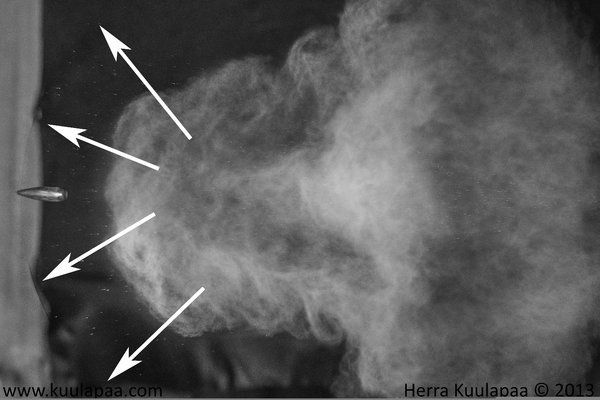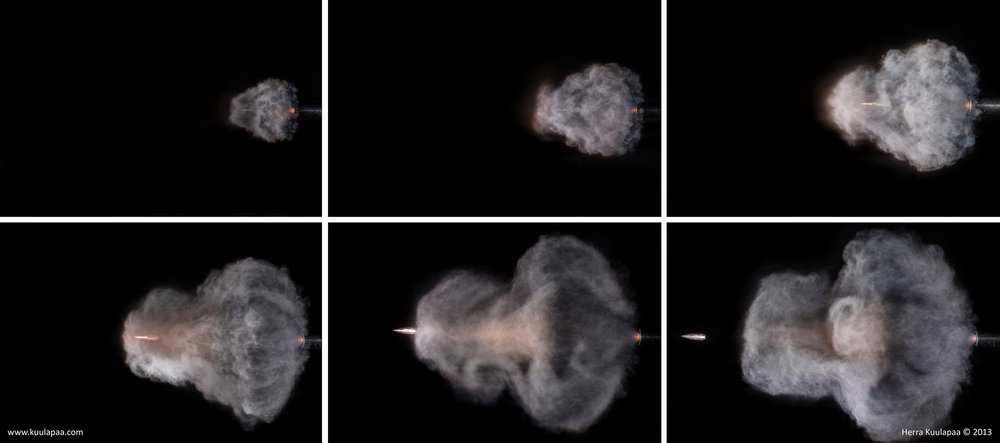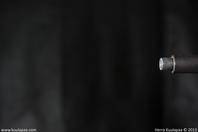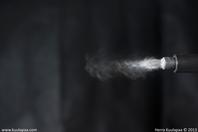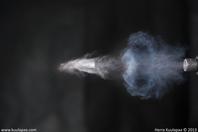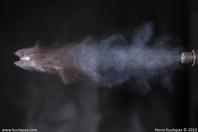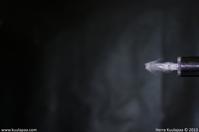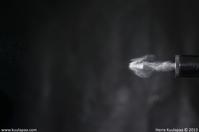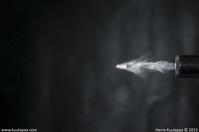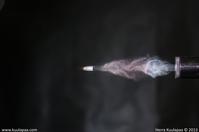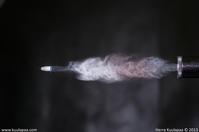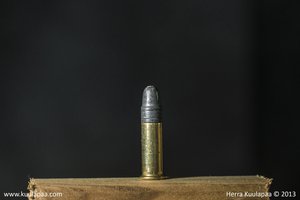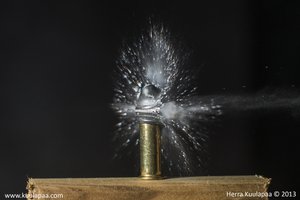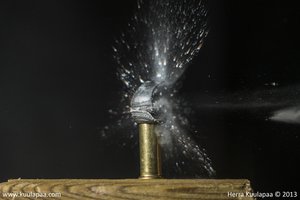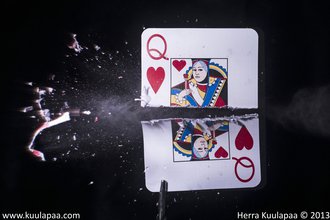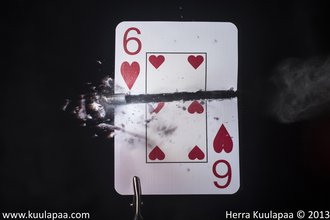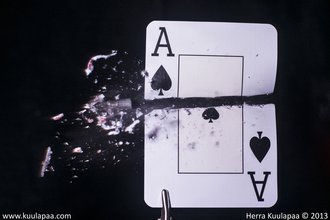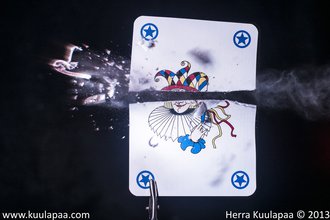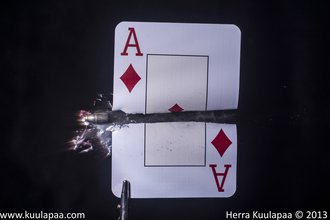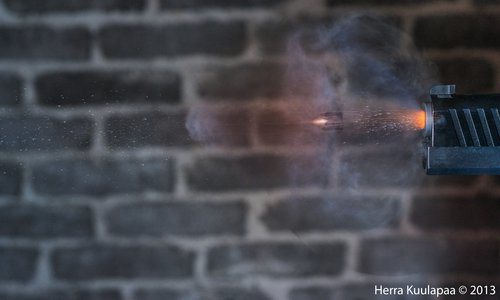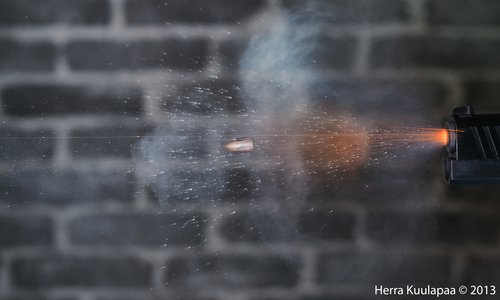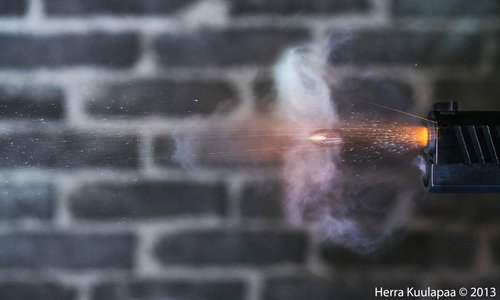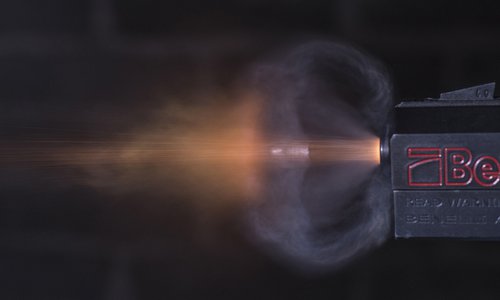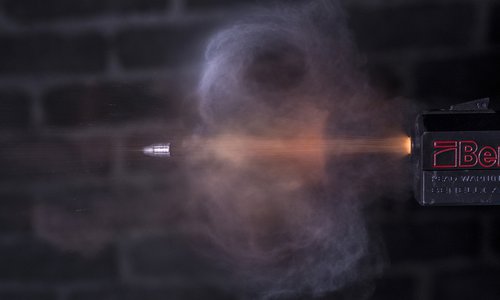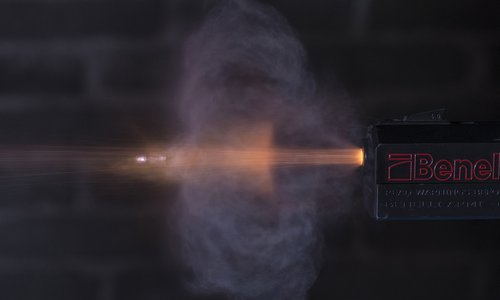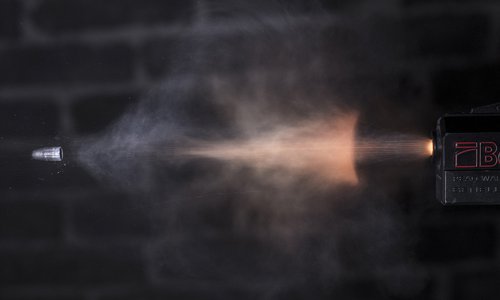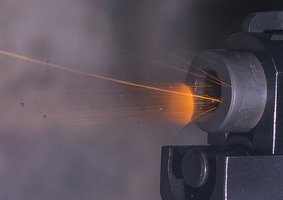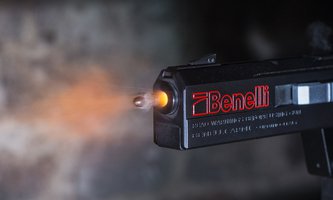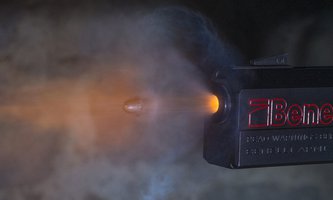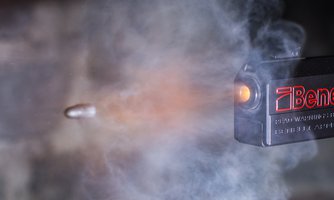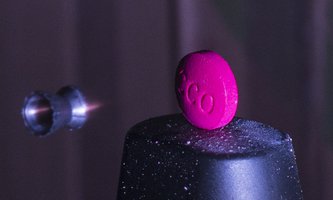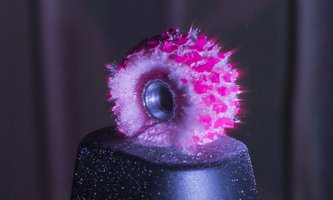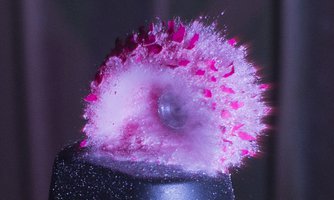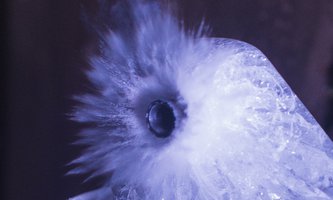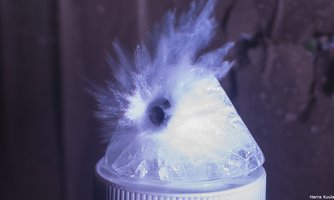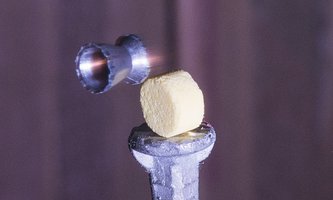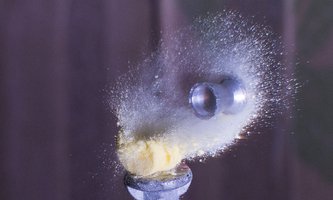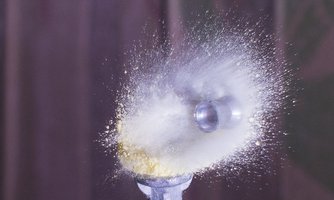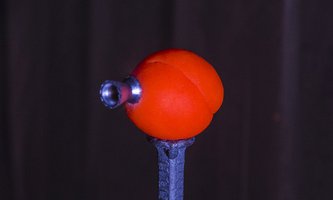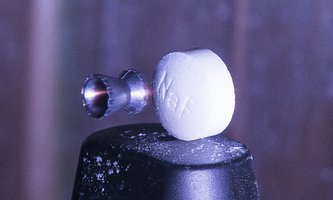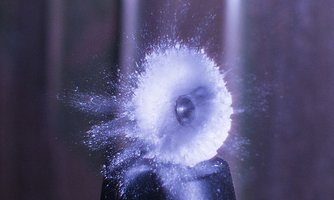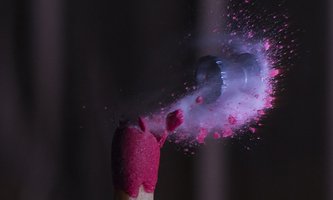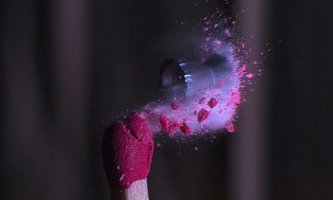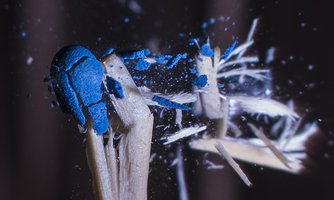Herra Kuulapaa
High Speed Ballistics Photography
This site emphasizes importance of firearm safety and proper handling of firearms. Weapons are not toys and they should never be considered neither treated as such. We do not participate in any communication attempts involving suspicious politics, racism or general hate talk. If you agree please continue and enjoy our work!

Picture products available.
I've been asked if picture prints could be provided so I have setup a test run with Photoshelter. Click to see them and material options: Picture prints, canvases and other products page
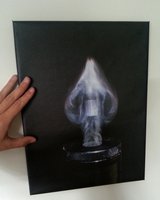
20. September - .500S&W Magnum / The most powerful handgun in the world!
This is it. The .500S&W Magnum, Fifty cal., 12.7mm - it goes by many names but common to them all is that they represent the ultimate bad assness. It's hard to describe it but .500S&W Magnum makes .44 Magnum look weak and that's a pretty good analogue. Of course .44 Mag isn't weak by any means but when you compare both cartridges in your hand the .500S&W just is the hard core one.
Why did man invent this beast? It's hard to say like it is hard to define whether this is a handgun or a rifle if you know what I mean. One thing is certain though. It was designed to be the most powerful handgun in the world and it's all that matters. Let's look into the numbers and put them in context. In Finland we can hunt moose with 10 g (154 gr) rifle cartridges if they have 2000 Joules of hit energy at 100 meters (110 yards) away. Bullets of this monster weight usually between 20-30 grams (300-500 gr). It means hit energy of 3000 - 3500 Joules at the muzzle. But you can push it over 4000 J if you dare. That is a massive amount of hit energy. It's roughly double the .44 Magnum and ten times the 9mm energy !!! Ok, you need to remember that the .500 S&W Magnum was designed to be primarily a handgun hunting cartridge. But it acts also as a back-up survival handgun cartridge in defense purposes against large carnivores to persuade them not to consider you as a meal again.
How is it to shoot with? If you're experienced shooter it's not too bad. Well, it is bad to be honest and it will hurt your palms but with good grip you're OK as long as you don't plan to shoot full box with it at one stand. It can hurt you if you're not careful though. There is a good selection of videos in Youtube where you can watch people injuring themselves with this gun. They're good examples what not to do so you better learn from them before shooting this beast. Long fingernails are probably not a good idea with this revolver.
Massive amount of flames between cylinder and barrel takes care that I don't need to hide shooters face this time. Luckily we got that picture above with all flame shooting to the left so you can actually see the revolver. It could have been like in picture below. This model has a long compensated barrel and you can see gas shooting up from the vents. Longer barrel also suppresses flame shooting forwards. I know that many of you anticipated huge forward shooting flame but it ain't there. There is still clear amount of unburnt powder though and it surprises me. I thought that we had clean shots with this gun but no. It directs burning powder grains backwards to shooter so you better to keep your eyes shielded. If you're shooting this indoors then you better also take care of you hearing or otherwise you don't need to do that anymore. .500S&W Magnum makes so great pressure blast that you sometimes wish to have double ear protection. Pressure blast in our tests was so great that even though we moved camera back double the distance than in previous shots the camera got blast damage and it cost us $$ to fix it. So be careful with this gun.
This impressive revolver waits your visit at West Shooters. Don't let it wait too long :)
Bonus picture: Is it on fire or is it just me ? :
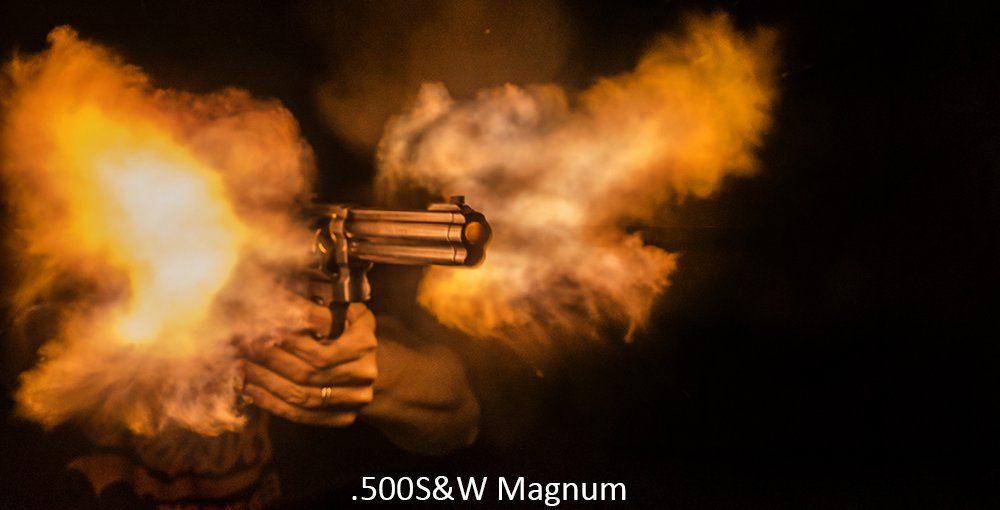
18. September. Should we get to real big bore business with The Gun on the right?
I'm quite sure it will surprice you!
But if you can't wait, then you can head to
West shooters and try it out. It's worth it!
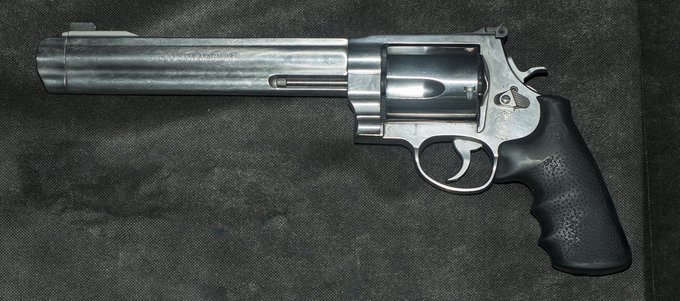
13. September - Ruger Super Redhawk Alaskan .44 Magnum
I have received many emails asking when shall we do "Dirty Harry Magnum". To be honest that would be a bit dull because of long barrel suppressing much of the flame. We give you something better though. A Ruger Super Redhawn Alaskan .44 Magnum with 2 1/2 inch barrel. No, you don't shoot long range with it and it isn't even meant to do so. It's purely intended to save your life in wilderness. Why, you ask? well, there are some hairy animals with sharp teeth, big claws and pointy ears out there and I don't mean rabbits. If you find yourself in situation being charged by big dangerous creature you'd probably wish to have something in your hand than just gloves. But don't do this in Finland because if you do then you end up losing this and every other gun in your collection due to hunting violation, firearm law violation and several other interesting things. And as a bonus you'll pay up to 15.000€ (nearly 20.000$) fine for saving your life. So, you better save your life in Alaska than in Finland. It's cheaper and safer to let bear eat you in here.
Let's talk a bit about .44 Magnum cartridge. Despite of being very close to diameter of .45ACP the .44Mag is totally different beast. Average .45ACP round generates ~650J of hit energy while .44Mag makes easily 1600J and can be pushed much more beyond that. This specific gun however cannot utilize all potential of .44 Magnum cartridge because of very short barrel. It simply cannot burn all powder. As you can see there is huge cone shaped spray of unburnt stuff flying in the air. With longer barrel show would be different.
Ok, you may have noticed the flames. They are something we haven't seen before. Especially when you look picture below and huge left side flame in it. Interesting thing is that major amount of the flame is escaping between cylinder and barrel. That short barrel seems to puff bullet our so fast that powder mass just flies out unignited. Is the bullet wobbling? Hard to say but it looks a bit more tilted than previously shot .50AE. If you look at middle picture you can see burning fragments shooting back towards the shooter. This is visible in all of the revolver shots we have taken so far so be warned. Your eye is pretty sensitive thing to high velocity burning stuff.
Take a trip to West shooters if you live in Finland and wish to try it out
Bonus picture: Flaming like none before!

7. September - IMI Desert Eagle .50AE
Magnum Research Inc.designed and Israel Military Industries manufactured it. It is considered the first line "defense" of pistols against high caliber revolvers. Yes, we're talking about Desert Eagle .50AE. With AR rifle type bolt and gas piston operated reload cycle it resembles more of rifle than pistols we're used to. Those design methods make it look big and it does also really feel such. It practically radiates the fact it uses the biggest self loading pistol cartridge there is: .50 Action Express. Small remark should be made though: Even with equally bold diameter with its revolver counterparts .50AE cannot compete in hit energy with longer S&W versions due to lower bullet velocity but we'll come back to that later.
After introduction we can get to interesting part. First of all what pops to eye is the big .50 bullet. It is big, just compare to fingers of shooter if you doubt it. Take a look at those 9mm and .45ACP. Immediately you see big difference in size of the flame. This pistol really lights up. There is impressive amount of hot gas rushing out from barrel and that large visible muzzle flash starts to eat it when it comes to mixed with oxygen of open air. But how much more there could be if all powder was consumed? There is huge spray of unburnt powder and other residue with this pistol. It forms clear expanding cone you difficulties to see. I thought that 9mm and .45ACP below made much powder adn residue spray but I was wrong. They're nothing compared to Desert Eagle .50AE. It is rather short round but pressure maximum is approximately equal to both 9mm and .44Mag while .45 is only half their pressure. It can be that spray is also related used specific Topshot [corrected 9.9.2013] cartridge but that needs to be tested. Gas piston operation makes one characteristic effect. You can see gas bursting out from bolt.
So, what can we wrap up. It is big gun, which shoots big bullet accompanied with big flame. It's not very useful as sports gun due high cost of shots and notorious recoil, which differs from so called single wave revolver recoil due to slide movement. Check this video what I mean. Overall very impressive pistol and biggest self loading one you can get!
If you happen to live in Finland, take a trip to West shooters and try it out.
4. September - Veteran 1911 Colt
Time to present you more results and this time we got nothing less than legendary Colt 1911 .45ACP. I’m sure this piece of history needs no introduction but for those who are not familiar with it I can say that it is one if not the most iconic self loading pistol all time. Especially for US guys but elsewhere too. It has long history and yes, 1911 stands for the year. Like previous tests have shown used cartridge makes large effect on muzzle flash and particle cloud.
For 1911 we used Magtech 12,6g (200gr) lead semi wad cutter (LSWC) and like previously there are unburnt particles visible. Theory however says that lead bullet seals barrel better than FMJ and that may reduce spray. Cloud of smoke is very predominant and somewhat thicker than with 9mm. I’d expect this difference to be clear on forensics point of view. There also seems to be a bit more glowing particles than with 9mm. Pistol itself is not much visible behind cloud and you just need to trust on us that it is there. Muzzle flash seems to be, at least with this Magtech, quite mild. I’d estimate that CCI Blazer Brass with 9mm makes bigger visible flash than this .45ACP. Both some and flash characteristics may have something to do pressure difference between 9mm and .45ACP, where latter run roughly half of the pressure of 9mm. Just look the barrel thickness of 1911 and you know what I mean.
Safety first: Remember to wear your safety gear always when shooting. Some pictures show clear burning particles flying backwards to shooter!
3.September 2013 - Scientific content - Differencies of powders

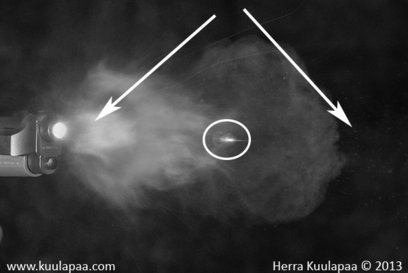
Small dose of educational content. In masked man picture below you can find big spray of unburnt powder and other residue. This is same effect with earlier 9mm STI Edge pictures. There are some differences though. There is picture pair on left shot with Magtech. In upper picture of them you can see prebullet residue cloud that is mainly left there by previous shot. Residue is now pushed forward by pressure traveling ahead of bullet and gas leaking between bullet and barrel. After bullet comes second, larger particle cloud and that is originated of shot itself.
In picture above you find different kind of powder burn behavior. That is shot with CCI Blazer Brass. Typical for this cartridge is pretty massive visible muzzle flash. Interestingly that flash is actually caused by powder still burning when bullet exits barrel. Flash is eating that residue and rear particle cloud is significantly smaller. What this means then? Well, there should be little less cleanup to be made if you are shooting indoors.
What can we learn: Powders are different and remember to use your safety goggles.
1.September 2013 - Warming up again, huge flame warning given!
Previous couple of weeks have been a bit silent but now I have some really interesting news. We've setup a joint project with West Shooters ry. a Finnish shooting range and store to provide you some hefty material.
First test was done yesterday and I'm happy to say that we have great amount of new and impressing stuff coming up. Here are couple teasers. Let's warm up with Guy shooting 9mm Beretta 92FS Brigadier INOX on above and some shiny revolver gear with smallest bore of .44 on the left. They really make your palms sore!
I'd like to remember you all that purpose of the site site is to serve as international information provider of firearms ballistics and behavior. Although pictures have certain entertainment value the main motivation for us is to provide you information. Mask above does not imply anything except our intention not to personalize this site anyway.
22. August 2013 - Preparing for next major :) event
Yes, it has been quiet for a week now. Unfortunately my pay job has taken so much time that I haven't been able to shoot anything by anything. And yet I'm traveling whole next week but we have plans for the next step. Oh yes, a Major test. For it I went little shopping today and what I got was those flatheads on left. No, they're not .44 magnum, we're going major this time: 500S&W!
Before you get too excited I must say that I have doubts whether we can pull that bullet visible under all that flame packed in that no so small cartridge but we'll try.
16. August 2013 - Colt 7.62x39
Here is second AR-15 rifle muzzle brake picture series. And this time I can really call it series. But why to do second one you may ask? Well, because this ain't .223Rem anymore but Colt 7.62x39. So we're talking about heavier bullet and slower muzzle velocity. Bullet is 128 gr copper jacket full lead core. Actually bullet diameter is .310 rather than .308 so rifles bite it better. Barrel is 1:12 twist and soft copper jacketed .310 bullet functions really nicely with rather gentle rise. Bullets are remaining stock of late Finnish bullet maker Archipelago.
Let's start with gas cloud. Powder used with 7.62x39 was Vihtavuori N130 while .223Rem test had higher energy density Vihtavuori N540. Usually 7.62x39 is reloaded with Vihtavuori N120 type powder but I some reason like N130 better. It has one drawback though and that is visible as particle discharge following bullet. That indicates that whole load is not properly combusted and powder is lost, which can lead to pressure/speed variance. Maybe I need to adjust my load or change to faster burn rate powder.
Muzzle velocity was not measured but according reloading data it was approx 700 m/s or 2300 fps. Comparing these two cases is of course difficult and rather subjective than objective but I'd estimate that 7.62x39 brake is directing more gas forwards. This is however expected due to bigger bullet diameter and different brake structure. I'd guess that higher pressure of .223Rem makes it better suitable for compensator use than 7.62x39. I must make remark though that Colt 7.62x39 high very good to shoot with and practically there is very small difference of feeling to .223Rem.
13. August 2013 - Art of rifle
This time I haven't got anything new stuff for you but something from a bit different point of view. You can see that this is actually same image than below but it's same time one of the most beautiful ones in all simplicity. Just minimal amount of gas flowing out of the brake bullet just about to exit as well.
Sometimes stuff just looks better black and white. It could be just me though. What do you think?
Next I'd though to bring you more of AR brake material but a bit different: About Colt 7.62x39, which is one of my treasures.
Stay on channel :)
11. August 2013 - This is what you've been waiting for: AR-15
Finally we got into subject: AR-15. This is something I've wanted to do for very long time. Plan goes back seven years to 2006 but back then we got no resources or equipment to do this. But now we do and here is what we can do. It's important to remember that even though results are as nice they are this is in the end just concept test with AR-15 type weapons. Setting up this test took some careful planning and for a while it looked unlike to get everything and everybody together right time and place. It did work out though and I think we really succeeded.
What we did do then? Weapon is AR-15 chambered 5.56 NATO and I don't think it needs any further introduction. Plan was to illustrate how muzzle brake directs gas and how early stage bullet ballistics look like. Ammunition used was standard 5.56 M193 55gr FMJ and that longer bullet is self loaded cartridge with Hornady 75gr BTHP Match. Why? because that 75gr Hornady just looks so damn good :) No, it won't work too well on 1:9 20" barrel but still. Brake used in this test was homemade copy of F2 by handy fellow shooter with lathe, Dremel, drill and file. Yep, you read it right! It has three relatively large chambers and two upward facing compensation holes.
So what did we found out? Pretty much good enough visual explanation why AR-15 with brake feels so good compared to unbraked one. There isn't actually much gas following bullet already exited brake, which brings silencer tests to mind. 5.56 NATO round is high pressure cartridge and recoil is caused by high velocity gasses escaping barrel forwards. When these gasses are directed to both sides this back driven force is greatly decreased. In this case it practically ceases to exist. There is of course effect of bolt carrier and spring like every AR-shooter knows but otherwise it just makes loud noise. It has been argued whether two chamber brake is as effective as three chamber one but although these images won't give you clear picture what is happening I'd estimate that there is enough gas left in third chamber to have effect from it too. In future it would be interesting to take pictures from above to show how gas is really flowing. There is reason for additional tests then.
Enjoy images and remember to click them big!
10. August 2013 - Eye candy for enthusiasts
Why do I like so much small caliber .22lr? It's so modest, well controlled and you can do very precise things with it. You know what I mean. That small lead bullet makes good seal for powder and lets it burn without spaying it shot gun like what happens with 9mm. These are pictures of my friend's pistol. Old Browning Target model but manufactured under license by Belgium FN. I can say it's really good gun to shoot with. Not a real competition pistol but a good gun. He asked me to take some pics of it and make them look good. As good as .22lr can be done so here are the pics. I think they came out quite decent.
8. August 2013 - .308 rifle bullet shock wave distortion
Here is small extension to .308 images below. This is a high sensitivity image of 147grs FMJ .308 bullet in flight and what is interesting you can see supersonic bubble pressure wave in there.
Bubble however is not pressure wave caused by supersonic bullet but high velocity gas “explosion front” released after bullet from barrel. It is much better visible than sharper cone type bullet wave, which can be barely spotted in picture if you know where to find it. It is so weak though that seeing it requires some imagination but there it is and it can be found through image processing. I try to get better picture of bullet wave later.
7. August 2013 - Faster, stronger, longer .308
Enough with small calibers already. Let's switch to bigger, faster and stronger. So here is high speed photography image series of .308. Rifle was Sako Forester with track record 50+ moose. Impressive gun I must say. Ammunition used was Sellier&Bellot 9,55 g (147 grs) FMJ with muzzle velocity 850 m/s (2800 fps). With quick glance pictures look almost same with smaller rifle pictures but then picture scale comes to mind. We're in very different league now.
Series has been taken on different shots and bullet position has been adjusted few centimeters in each shot. Speed of the bullet is approx one centimeter per 10 microseconds. It's one fast son of a gun. When you look pictures you can immediately see amount of gas and pressure released after bullet has left barrel. Bullet is in middle of gas cloud for first 40 cm (1 1/2 feet). Pressure is also so great that I managed to damage my camera and it went to repairs. Word of warning, it may not be wise to photograph high power guns so close.
Below you can see one picture of bullet just leaving the barrel. There is so violent burst of high pressure gas pouring behind that bullet is almost lost in cloud.

6. August 2013 – Spotting bullet in flight with own eyes

During my experiments I have noticed many interesting things on bullets and their behavior but perhaps most fascinating is that human eye is able to see flying bullet in mid air. By this I don’t mean anything like calling shots in long range by pressure distortion trail caused by bullets but actually seeing them stopped while their flight. This of course requires some technical assistance in form of very short burst of light.
What I found out during air gun tests to my surprise was that I could see frame in my eyes before looking at camera screen. Eye is so sensitive and yet so slow that frame stayed in retinal rods long enough for brains to comprehend it. Surely 190 m/s or 620 fps bullet is so slow that it doesn’t mean much right? I though so. But same thing repeated also with .22LR and 9mm. Fastest .22LR shots were over 400 m/s or 1300 fps. Impressive isn’t it? Not yet, because I’m telling you that you can see .308 and .223Rem bullets as well in right conditions. This is impressive! So, who would guessed your eye is so good. Even very high velocity like 970 m/s or 3200 fps isn’t too fast for your eyes and lump of fatty tissue behind them.
4. August 2013 - Silencer test - .22lr
I'm happy to present you a .22lr suppressor/silencer comparison to plain barrel. In this test I used cheap suppressor, which uses simple chambers without any clear gas reflecting baffles. For .22lr I've found this adequate structure. With high pressure rifle calibers proper suppressors like BR-reflex are really effective. This is part one and more comparisons will follow. At least it is my intention to do .223Rem suppressor test as well. I've noticed some color fluctuation of pictures, which hopefully aren't warning of coming component failure. At least everything works fine, so far.
Let's get into subject. Instead of trying to explain things verbally it's easier to present findings as images and leave final interpretation and enjoying of images to you. Above is picture series without silencer and below is silenced one. Both series show pre wave gas flowing out in front of the bullet but difference comes after the bullet. Middle picture above shows high pressure gas bubble forming after bullet has left barrel and no longer acts as plug holding back high pressure gas. This creates typical gun shot bang (in addition to supersonic bullet sound).
With suppressor that same high pressure bubble has already formed but inside of the tube, which distributes gas between suppressor chambers and allows gas to expand in controlled manner. When gas finally flows out of the suppressor its speed has decreased. There is no bubble formation with suppressor and typical gun shot bang. Well, to be honest once again I must say that even .22lr makes such loud noise indoors and in defined space that you really want to cover your ears. In open space noise is dispersed and what matters is nature of the bullet (sub- or supersonic).
1. August 2013 - Trick shot
I once heard a story about marksman, who could hit tip of the cartridge 15 meters (~yards) away with handgun and even with single shot. Story didn't specify what handgun it was or what kind of cartridge was hit. I have tested that few times placing brass on top of the pole and trying to hit it, rather close I must admit. It is doable but takes much more than single shot.
Now things get interesting; what happens if you actually manage hitting cartridge at tip of it? It's probably not very wise thing to do and to minimize risks I rather start small scale so .22LR it is. Picture has been taken on exact moment bullet is in middle of the stationary one. Not much science or wisdom in these shots but they look good so enjoy.
Word of warning: Don't try this without proper shielding. Some high speed lead is directed downwards through casing and it most likely compresses powder and primer to ignition point. This then causes explosion of casing and brass fragmentation.
30. July 2013 - Wobbling bullets
You may have noticed that bullet seems to be tilted in certain pictures. Barrel angle may be slightly off horizontal axis in some cases but bullets really are tilted. Well, they're not actually tilted in any fixed direction as they rotate and wobbling of the bullet is dynamic during flight. In other words bullets can either stabilize or tumble during their flight. Pistol caliber bullets often tend to wobble when they leave barrel and theory says they stabilize during flight. These images show you how much bullets actually can wobble.
29. July 2013 - Too much smoke
How much smoke is too much? Nothing beats black powder pistols, right?
Well, I guess not, but what you're looking at is once again just .22LR. What in earth is that cloud of smoke then. Answer is the Remington Thunderbolt. It makes smoke like nothing else. Picture is little boosted to make those fine structures visible but not much. CCI standard is a pale comparison. But surely Remington Thunderbolt makes good bunch with higher velocity? It does, on average but if you shoot pistol then it may not be your number one choice. Why, you ask?
Because by my experience and based on test results performed by shooting range friend there was no .22LR cartridge available with higher variance on pistol muzzle speed than Thunderbolt. It is important to notice that it may function differently and much better in rifle but in pistol muzzle speed variance between slowest and fastest shot was high = ~58 m/s (189fps) n=50. Slowest shot was 260 m/s (855fps) and fastest 318m/s (1044fps). Statistical parameters were Avg=301,7 m/s (990fps), Median=303,5m/s (995,7fps), Stdev=9,64.
It kicks good and makes loud bang and smoke. Even a bit too much.
28. July 2013 - Deck of cards
Splitting card in half by shooting is popular trick performed by exhibition shooters. But what really happens at that exact moment? Well, net is of course half full by these images but usually really small and what I try to do differently this time is to provide you high resolution pictures. If you fancy them enough you can email me because I have even higher res ones approx 4000x3000 pixels of size. It should make nice picture to your wall if you like.
Anyway, these pictures didn't come easy. Well, to be honest the right ones needed only pulling the trigger but I wasted half of the deck making these. It was great fun though and very educating experience. I must say that I really appreciate real marksmans who are able to take shot like this at longer distances.
Are these still only recreational, I think not because we can learn something from them. One thing is that bullet is actually affected quite much by the card. .22LR is very light weight and relatively low speed ammunition with not so gear kinetic energy. This is quite well noticed in joker picture. Bullet is heavily tilted after card split. Also top row Ace of hearts have bullet climbing up. Well, line of fire is little tilted but you know what I mean.
You may notice that bullets look different. Ace of diamonds was shot by Remington yellow jacket, which has much higher velocity (1500fps or 450m/s) than dark bullet CCI standard and silver colored Federal Champion.
Enjoy, I have more stuff coming up soon :)
19. July 2013 - 9mm STI
These are 9x19 (9mm) test shots, a proof of concept for faster shot detection. Colors may look a bit odd but that is because I have reduced muzzle flash effect and removed excess blue haze out of the burn gasses. Backround sucks but thiese are just test shots. Gun used was 2011 frame STI. There was surprisingly strong blue haze in air after only couple of shots and that shifted color balance. Ammunition used was standard Magtech 9mm 124gr (8.04g) FMJ with measured ~340 m/s muzzle velocity. We noticed it takes ~600 µs for bullet to exit from barrel, which complies well to simulated estimate (thank you, guy who recognizes himself in here). Dwell time is much shorter when compared to .22LR we shot previously. For .22LR it takes ~2700 µs although velocities are not so different (286 m/s vs. 340 m/s). Reason is pressure and powder burn rate.
But let us get to the pictures. First thing that draws attention is massive amount of debris flying after but also in front of the bullet. That is both residue from barrel and unburnt powder following bullet. Interesting is that the cloud traveling in front of the bullet is so thick and much ahead bullet. I expected only some individual grains but there really is much of it.
Let's call picture in left upper corner as number one and picture on right as number two and so on. In picture one you can see first pressure wave have pushed pre bullet residue out of barrel and second, higher pressure wave have just exited barrel after bullet. This pushes gas around the bullet. There is thicker cloud of powder debris following bullet. If you look closely you can see round pressure distortion circling around muzzle hole. There is also second wave traveling in front of bullet but that is very hard to spot in these images. In second picture pressure continues to decrease inside of barrel and more debris is being pushed out. It starts to look like shotgun at this point. You can see same bubble like pressure distortion traveling in front of the bullet but fainter. Check also how soon slide starts to move and how little it actually moves compared to bullet.
Third picture serves as science example. I boosted image a bit more to make pressure bubble properly visible. Also gas flows are more clear in this picture. in fourth picture bullet has almost left frame and is out of the gas doughnut area. Gas doughnut appears to expand only to up and down but that is optical illusion as lens is focused in the center of the cloud and dissects it leaving side clouds out focus. Gas continues to exit from barrel decreasing pressure. Shotgun like powder residue spray has expanded wide but still there is residue flying out from barrel. This amount was really unexpected. I'd thought 9mm to be cleaner than .22LR but confirming this would require more reference shots. Maybe we get to it some day.
One thing to learn and remember: Safety glasses - you'd better not shoot without them.
17. July 2013 - .22LR Benelli
Here are couple more images of .22LR bullet leaving barrel. Like you may have noticed last ones didn't have bullet in sharp focus. This is due to very narrow dept of field. Pictures were taken with Nikkor 50/1.8D and with focus distance of 40 cm there is only around 10 mm focus tolerance in front and behind of bullet. This is the dilemma, should I go closer with wider lens and risk lens obtaining more dept of field or go further away saving lens but losing also focus tolerance. Well, I feel that 50mm lens in front of 35 mm sensor gives enough safety distance to bullet and adequate focus.
Because of this focus and safety balance these images were taken directly from side of the gun ensuring sharp bullet in them. Images are taken with slightly different delay from ignition and are naturally from separate shots. Despite of separate shots you can see some differences in burn gas cloud but also very much similarities due to repetitive behavior of gasses. Flame of the shot is rendered to picture 1 due to setup although it actually happens in slightly different time.
In first picture you can see exited compressed air and burn gasses traveling in front of the bullet forming back moving loop when high pressure gasses are released after bullet. This doughnut is rapidly expanding and moving forward in second and third picture. On forth picture cloud is already dispersing and pressure in center of the cloud (behind the bullet) is moving gas forward. All these event happen in fraction of the millisecond so they could be considered rather fast.
Word of warning: Look closely to pictures, you can see much fast flying lead and unburnt powder particles. Wear always your safety classes when shooting!
Ps. 9mm test was success and produced some interesting pictures. I try to upload them here soon.
8. July 2013
We also tested 9x19mm pistol to stop bullet like we did with Benelli. However this test was failure. This hobby provides almost endless supply for disappointments so be warned. Nothing broke though, this time.
Main issue was was due much shorter barrel time than in .22LR pistol. With 9mm we simply were not able to tune triggering fast enough to comply with 0,6ms barrel time. .22LR was considerably easier with approx four times longer barrel time. Maybe this also explains partly why it is so important to maintain good hold after shot with rim fires.
Setup has been now improved to meet requirements of center fire calibers and 9mm test is due next.
Stay tuned!
28. June 2013
This is Benelli MP90 World Cup. It’s semi automatic .22lr competition pistol quite commonly used in sports. In this experiment it shoots CCI standard .22lr ammunition with measured average speed 286m/s (n=50, Chrony). Aim of the experiment was to capture exiting bullet at variable distances from barrel and image events happening there.
In first image you can see bullet that has just left barrel and pressure releasing behind it. If you look closely you can also see pressure wave forming round bubble around the bullet.
In second image pressure has already formed doughnut like cloud around barrel hole. Pressure bubble has traveled further away. If you look closely the bullet you can see odd marks, a bit like extending shards of lead leaning out from side of the bullet. Just where rifle marks start.
In third image bullet has moved few more centimeters and pressure in barrel has decreased more. At this point you can see bigger muzzle cloud formed by burn gasses and pressure still exiting is pushing burn residue consisting unburnt and still burning nitrocellulose and other particles out of the barrel.
Click on images to view them bigger.
18. June 2013
This is B12 vitamin tablet. This one had red filmcoating on it and putting bullet in it makes good show. Contrast between tablet core and coating helps us visualize impact nicely.
Couple words of warning: You better not shoot any harmful of even any medicines at all if you don’t know exact safety profiles of them. Tablets tend to disintegrate into fine dust and inhaling that dust is not usually a good thing to do. They’re not using safety clothing and respiration filters in medicinal factories for nothing.
Ice you say? When I was young it was quite common for kids to shoot around with air rifles and during winter we got good supply of blocks of ice. It was normal and pretty harmless most of the times. Nowadays we live in very different world where you get yourself arrested even walking outside with toy gun. People are panicking just about anything these days. For example in my home town old man was stopped by police when he was returning from hardware store with an axe. Yes, someone got worried about his plans. Come on, 70% of Finland is covered by forests, rest is usually water and in this case ice during winter time.
So, what happens when you shoot ice cube with air shot rifle. Well, cube goes away but interesting is that it actually forms some kind of solid/gas spray upon impact. Check yourself.
Have you ever wondered what happens when nitroglycerin tablets are shot with air rifle? In this experiment 0,5mg glyceryl tri nitrate tablets were shot with 4,5 cal air rifle. Unfortunately result was less spectacular than anticipated. There was no explosion or even combustion of any kind. Of course amount in each tablet was rather small but this should assure your safety walking nitroglycerin tablets in your pocket and even falling down on them. No, you don’t lose your leg like stepping on a land mine.
Air rifle bullet hitting fluoride tablet. Despite of relatively low kinetic energy the impact is nevertheless so tense that tablet dissintegrates to fine dust.
If you look closely the middle picture you can spot bullet clearly flattened on impact.
Air rifle bullet travelling ~190m/s hitting match head. In red head match pictures bullet was aimed just to scrape match head. Interestingly some matches ignited on impact although they were so called safety ones. Safety point of view it may not be the most wise thing to shoot incendiary targets indoors ;) In blue head image bullet hit stick below match head.
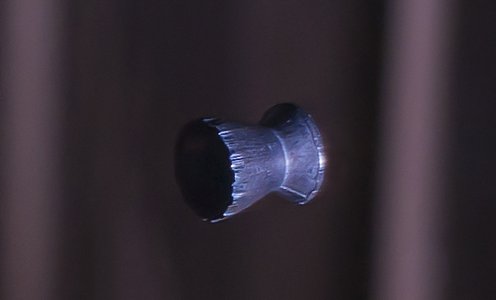
Cal 4,5 (.177) Air rifle bullet travelling ~190m/s suspended in mid air by high speed flash. Note rifle marks on bullet head and tail.
Copyright 2015 © All Rights Reserved by Herra Kuulapaa

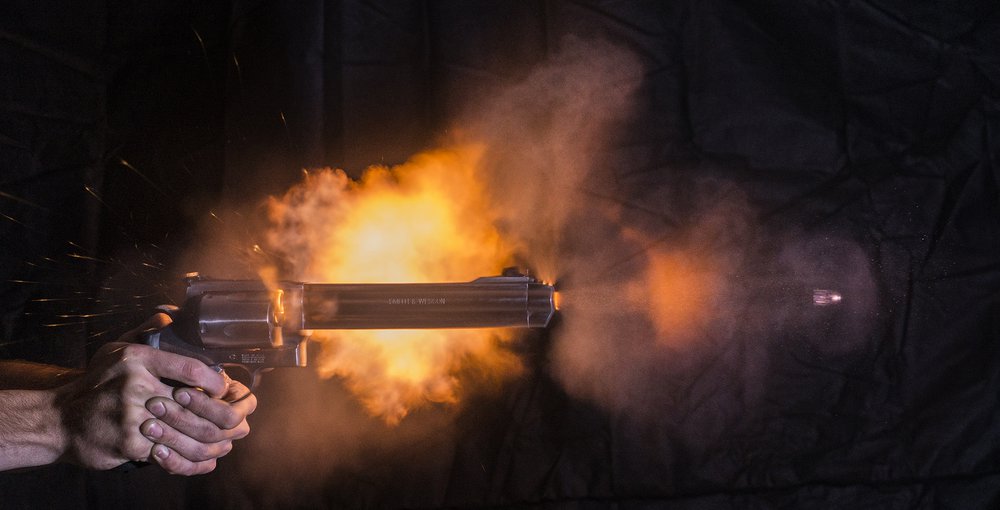

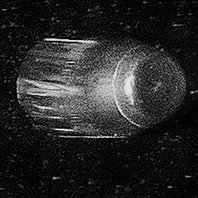
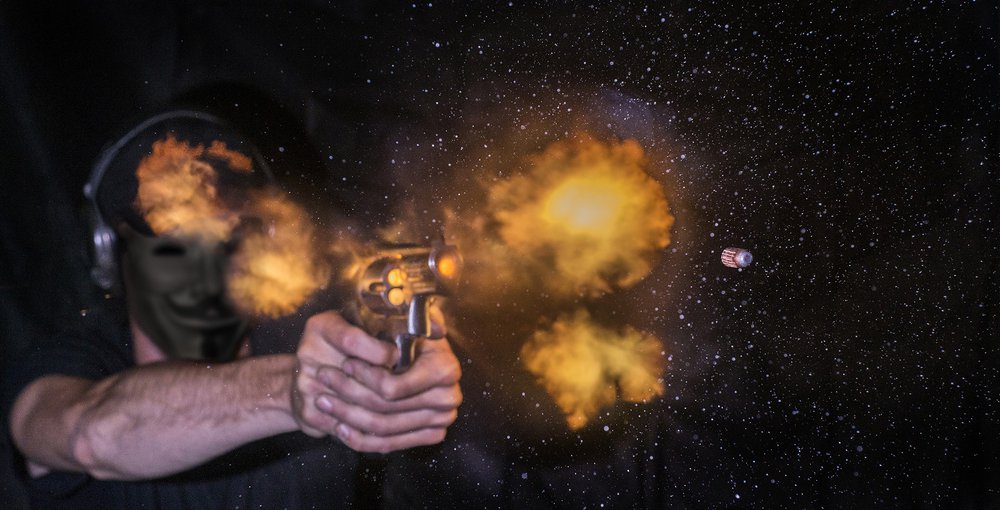
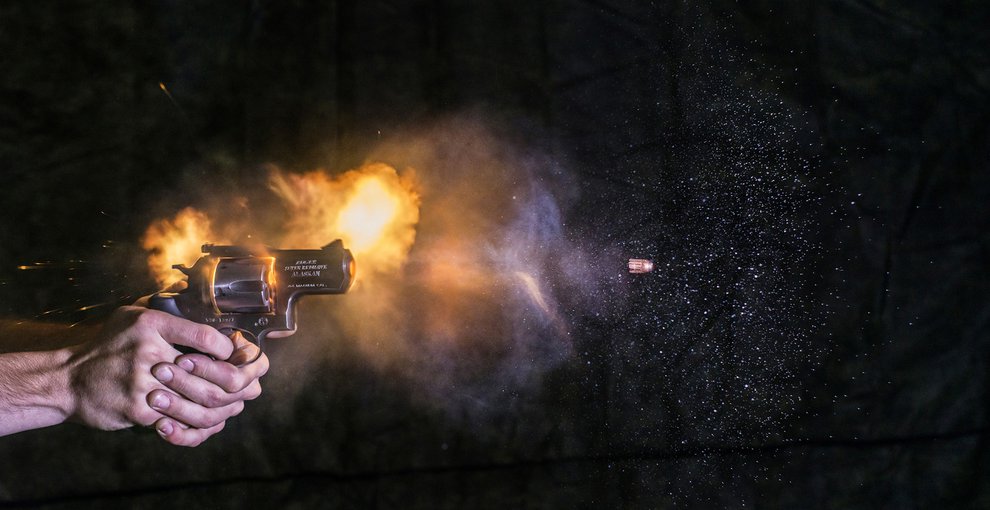
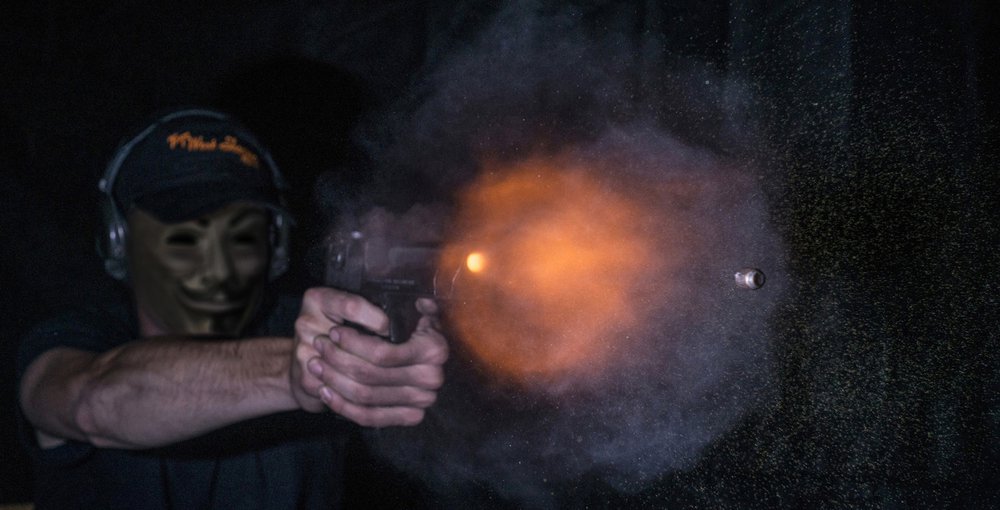
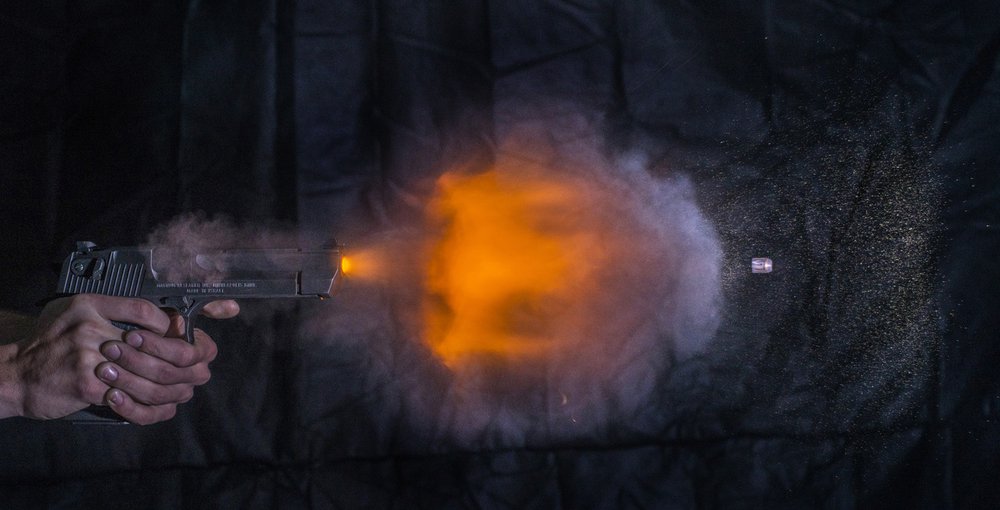
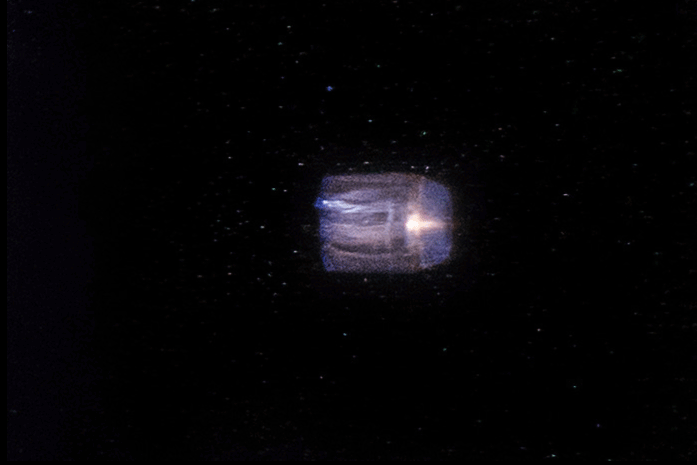
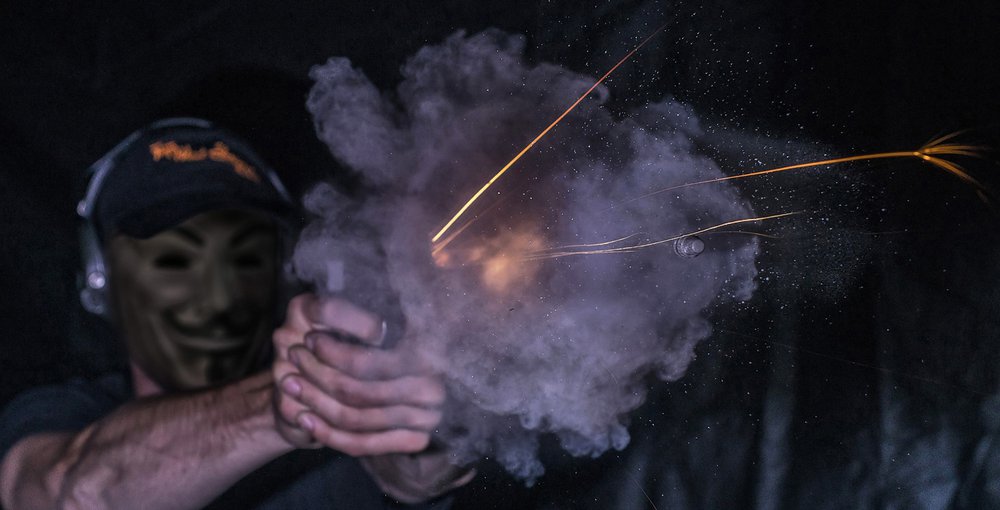
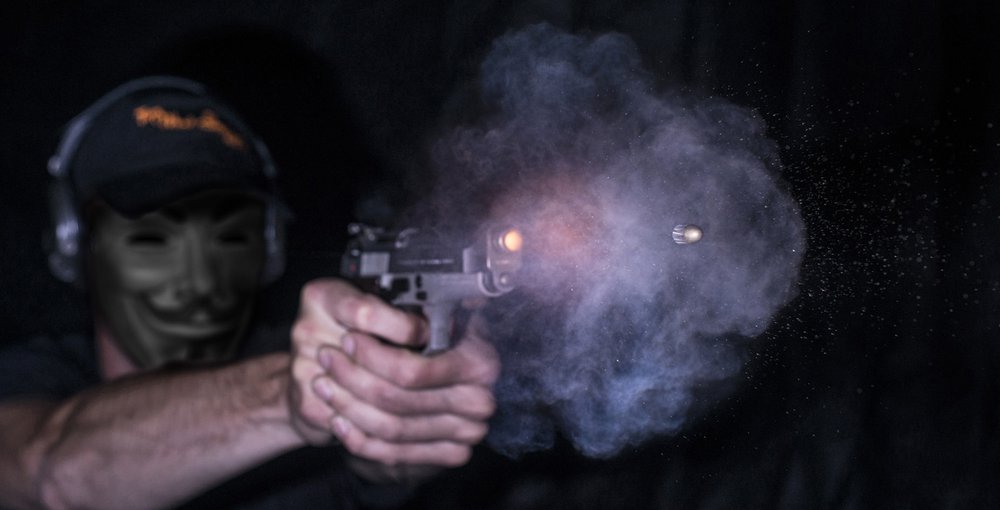
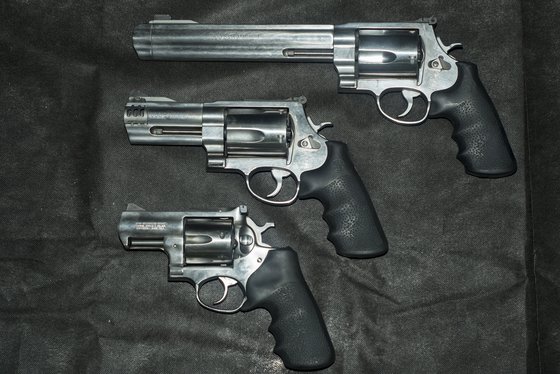
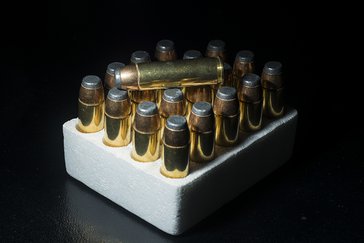
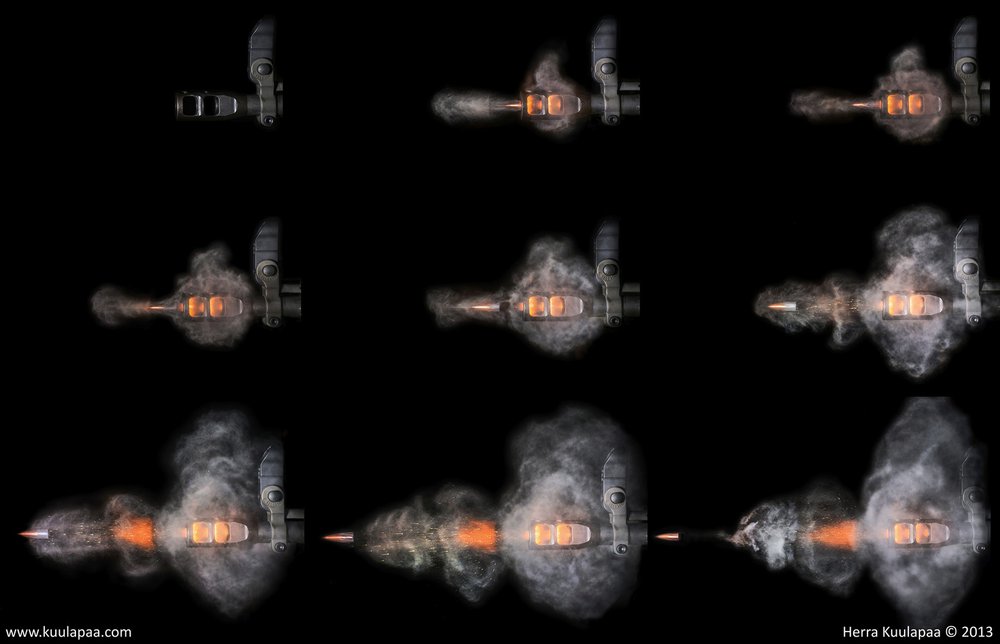
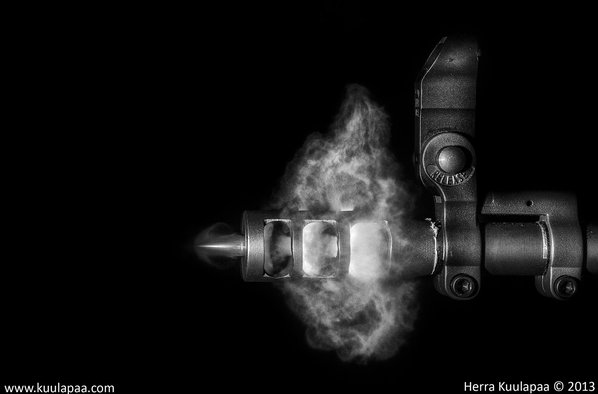
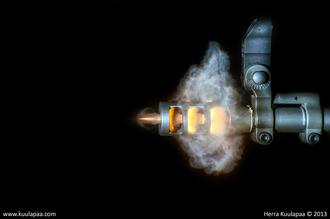
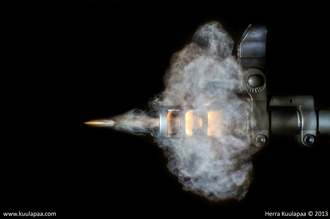
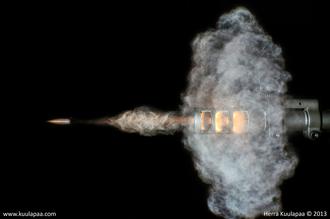
.jpg)
.jpg)
.jpg)
